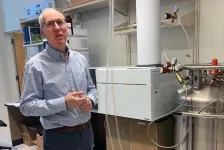(Press-News.org)
You can mend a broken heart this valentine’s day now that researchers invented a new hydrogel that can be used to heal damaged heart tissue and improve cancer treatments.
University of Waterloo chemical engineering researcher Dr. Elisabeth Prince teamed up with researchers from the University of Toronto and Duke University to design the synthetic material made using cellulose nanocrystals, which are derived from wood pulp. The material is engineered to replicate the fibrous nanostructures and properties of human tissues, thereby recreating its unique biomechanical properties.
"Cancer is a diverse disease and two patients with the same type of cancer will often respond to the same treatment in very different ways," Prince said. "Tumour organoids are essentially a miniaturized version of an individual patient's tumour that can be used for drug testing, which could allow researchers to develop personalized therapies for a specific patient."
As director of the Prince Polymer Materials Lab, Prince designs synthetic biomimetic hydrogels for biomedical applications. The hydrogels have a nanofibrous architecture with large pores for nutrient and waste transport, which affect mechanical properties and cell interaction.
Prince, a professor in Waterloo’s Department of Chemical Engineering, utilized these human-tissue mimetic hydrogels to promote the growth of small-scale tumour replicas derived from donated tumour tissue.
She aims to test the effectiveness of cancer treatments on the mini-tumour organoids before administering the treatment to patients, potentially allowing for personalized cancer therapies. This research was conducted alongside Professor David Cescon at the Princess Margaret Cancer Center.
Prince's research group at Waterloo is developing similar biomimetic hydrogels to be injectable for drug delivery and regenerative medical applications as Waterloo researchers continue to lead health innovation in Canada.
Her research aims to use injected filamentous hydrogel material to regrow heart tissue damaged after a heart attack. She used nanofibers as a scaffolding for the regrowth and healing of damaged heart tissue.
"We are building on the work that I started during my PhD to design human-tissue mimetic hydrogels that can be injected into the human body to deliver therapeutics and repair the damage caused to the heart when a patient suffers a heart attack," Prince said.
Prince's research is unique as most gels currently used in tissue engineering or 3D cell culture don't possess this nanofibrous architecture. Prince's group uses nanoparticles and polymers as building blocks for materials and develops chemistry for nanostructures that accurately mimic human tissues.
The next step in Prince's research is to use conductive nanoparticles to make electrically conductive nanofibrous gels that can be used to heal heart and skeletal muscle tissue.
The research was recently published in the journal Proceedings of the National Academy of Sciences.
END
Hypertensive disorders of pregnancy (HDP) and gestational diabetes (GDM) are two of the most common pregnancy complications and put pregnant people at increased risk of developing cardiovascular disease later in life.
Now, in a new study to be presented today at the Society for Maternal-Fetal Medicine’s (SMFM) annual meeting, The Pregnancy Meeting™, researchers will unveil findings that suggest these pregnancy complications may also result in worse cardiovascular health for the child.
In a secondary analysis of 3,317 maternal-child pairings from the prospective Hyperglycemia ...
Anyone who has ever been to a loud concert knows the feeling of ringing ears. Some people experience temporary or even permanent hearing loss or drastic changes in their perception of sound after the loud noises stop. Thanos Tzounopoulos, Ph.D., director of the Pittsburgh Hearing Research Center at the University of Pittsburgh School of Medicine has focused his scientific career on investigating how hearing works and developing ways to treat tinnitus and hearing loss.
In a paper published today in ...
As you scroll through any social media feed, you are likely to be prompted to follow or friend another person, expanding your personal network and contributing to the growth of the app itself. The person suggested to you is a result of link prediction: a widespread machine learning (ML) task that evaluates the links in a network — your friends and everyone else’s — and tries to predict what the next links will be.
Beyond being the engine that drives social media expansion, link prediction is also used in a wide range of scientific research, such as predicting the interaction between genes and proteins, and is used by researchers as a benchmark for ...
Birds can fly— at least, most of them can. Flightless birds like penguins and ostriches have evolved lifestyles that don’t require flight. However, there’s a lot that scientists don’t know about how the wings and feathers of flightless birds differ from their airborne cousins. In a new study in the journal PNAS, scientists examined hundreds of birds in museum collections and discovered a suite of feather characteristics that all flying birds have in common. These “rules” provide clues as to how the dinosaur ancestors of modern birds first evolved the ability to fly, ...
A new study shows that it is possible to use machine learning and statistics to address a problem that has long hindered the field of metabolomics: large variations in the data collected at different sites.
“We don’t always know the source of the variation,” said Daniel Raftery, professor of anesthesiology and pain medicine at the University of Washington School of Medicine in Seattle. “It could be because the subjects are different with different genetics, diets and environmental exposures. Or it could be the way samples were collected and ...
Legume plants have the unique ability to interact with nitrogen-fixing bacteria in the soil, known as rhizobia. Legumes and rhizobia engage in symbiotic relations upon nitrogen starvation, allowing the plant to thrive without the need for externally supplied nitrogen. Symbiotic nodules are formed on the root of the plant, which are readily colonized by nitrogen-fixing bacteria. The cell-surface receptor SYMRK (symbiosis receptor-like kinase) is responsible for mediating the symbiotic signal from rhizobia perception to formation of the nodule. ...
Modern populations of fallow deer possess hidden cultural histories dating back to the Roman Empire which ought to be factored into decisions around their management and conservation.
New research, bringing together DNA analysis with archaeological insights, has revealed how fallow deer have been repeatedly moved to new territories by humans, often as a symbol of colonial power or because of ancient cultures and religions.
The results show that the animal was first introduced into Britain by the Romans ...
Woods Hole, Mass. (February 12, 2024) – Studying a rock is like reading a book. The rock has a story to tell, says Frieder Klein, an associate scientist in the Marine Chemistry & Geochemistry Department at the Woods Hole Oceanographic Institution (WHOI).
The rocks that Klein and his colleagues analyzed from the submerged flanks of the St. Peter and St. Paul Archipelago in the St. Paul’s oceanic transform fault, about 500 km off the coast of Brazil, tells a fascinating and previously unknown story about parts of the geological ...
The replacement of regular salt with a salt substitute can reduce incidences of hypertension, or high blood pressure, in older adults without increasing their risk of low blood pressure episodes, according to a recent study in the Journal of the American College of Cardiology. People who used a salt substitute had a 40% lower incidence and likelihood of experiencing hypertension compared to those who used regular salt.
According to the World Health Organization, hypertension is the leading risk factor for cardiovascular disease and mortality. It affects over 1.4 billion adults and results in 10.8 million deaths per year worldwide. One of the ...
Statement Highlights:
The new scientific statement highlights heart disease as the leading cause of death for women and emerging evidence that has identified several gender-specific risk factors for heart disease in women, including complications during pregnancy and premature menopause.
Compared to men, women also have different symptoms of heart disease, are less likely to receive evidence-based therapies and are more likely to have adverse cardiovascular outcomes after a cardiac event.
Targeted public health interventions ...





